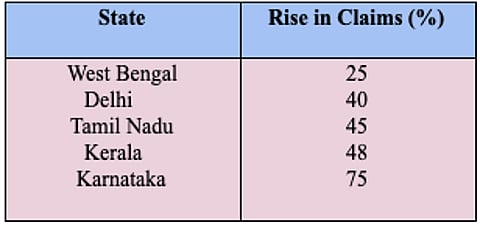While monsoons bring with it the pattering of raindrops and the aroma of deep-fried samosas and khichdi, it has its fair share of maladies as well. Yes. Monsoon brings with it an endless list of diseases as well including malaria and even jaundice or hepatitis to be more precise. In fact, hepatits is one of the most common diseases reported during monsoons.
Insurance Claims For Hepatitis Spike During Monsoons
Hepatits treatment, often prolonged needs to resort to health insurance policies.
According to World Health Organisation (WHO) Global hepatitis report for 2017 shows that an estimated 32.5 crore people worldwide are living with chronic hepatitis B virus (HBV) or hepatitis C virus infection. This indicates that the large majority of these people are at risk of a slow progression to chronic liver disease, cancer and even death.
Hepatitis is an inflammation condition of the liver tissue. It’s commonly caused by a viral infection, however, there are other possible causes of hepatitis. There are five types of hepatitis named A, B, C, D and E. Hepatitis B, C and D are blood borne. Hepatitis A and E are water borne and spread through contaminated water or food.
As monsoon threatens to lead to rise in cases of hepatitis infection and need for treatments subsequently. Needless to say, hepatits treatment, often prolonged needs to resort to health insurance policies.
Of late, insurance claims pertaining to hepatits has sought up substantially. Commenting on the this particular trend,
Bhaskar Nerurkar, head, health claims, Bajaj Allianz General Insurance said, “We see a spike in claims around the monsoon season, we advise people to take necessary protection not only against the disease, but also against any financial emergency caused due to a sudden diagnosis.”
India has over 6 crore HBV infected patients (second only to China) and constitutes about 15 % of the entire pool of hepatitis B in the world. Every year, nearly 6 lakh patients die from HBV infection in the country according to Institute of Liver and Biliary Sciences, New Delhi.
Types B and C lead to chronic disease like liver cirrhosis and cancer. Though the average claim size is around Rs 35,000, insurers have seen several cases where the hospitalisation expenses run into more than Rs 10 lakh.
To bear the financial burden Nerurkar suggested, “One should opt for basic health insurance policy which offer a minimum of Rs 5 lakh coverage, and one can top it up with a Rs 10 lakh super top up policy. Not only would this give you an adequate coverage, but it would also be an economically viable option – an apt financial shield against any health exigency.”
Most health insurance plans along with critical riders cover hepatitis. Before buying health insurance plan, insurer might ask a customer to undergo medical examination and charge appropriate premium based on the report. On the other hand, customer looking to buy health insurance after being diagnosed with hepatitis will have to pay higher premium or cover after completing the waiting period. Wisely choose your right health insurance plan to support your medical bills with wider cover.
Here are a few observed trends as per company’s internal claims data related to all kinds of diseases, and hepatitis remains a persistent reason for claims, across both metro and tier II/III cities.
There is a 30% rise in claims due to hepatitis since 2016-17 to 2018-19
The average age group that claims the most because of hepatitis falls within the age bracket 21-30 years
Over the past three years, consistently almost 65% of the claimants have been males. This might also be because of lower health insurance penetration amongst women
A seasonality trend is seen in rainy season for hepatitis claims (basis registration)
Surat, Ahmedabad, Mumbai, Delhi, Vadodara are the cities that claim for most number of hepatitis related claims settlements.
In the past 3 years, there has been a steep spike in hepatitis related claims from various parts of India.
